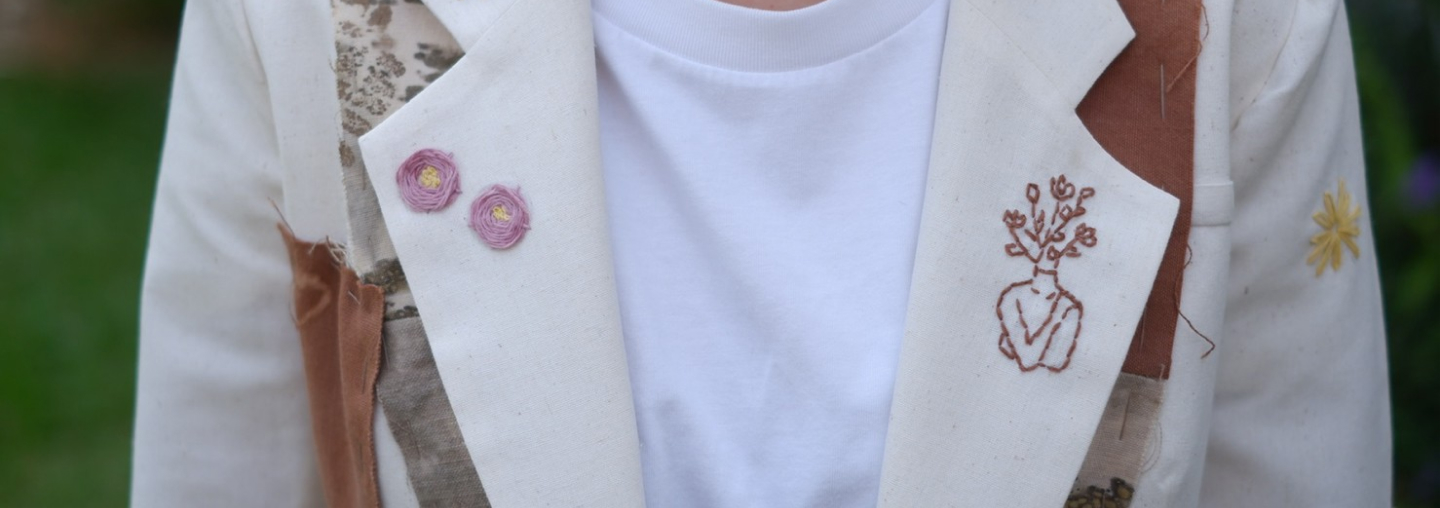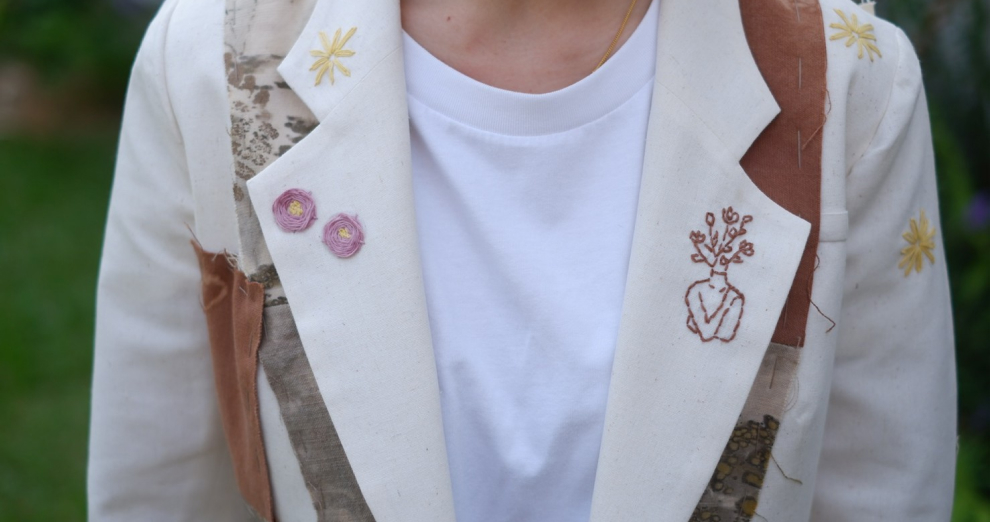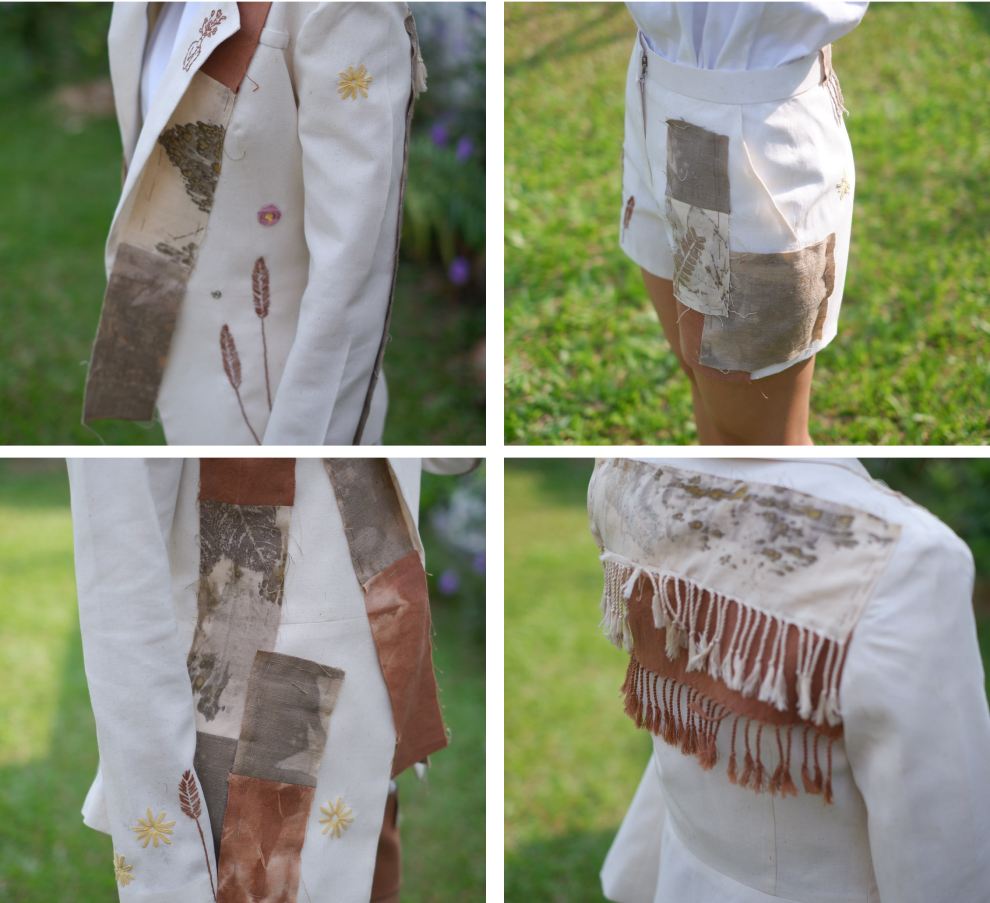
Back to the Roots
Dr. Chamaiporn Mitinunwong
Introduction :
“Back to the Roots” referred to clothing design based on the concept of circular fashion for working age of ≥ 25 years by introducing clothes under the new concept applying natural color printing, tie-dye from local plants in Nan Province, and craftwork by patchwork. This concept described the new world totally different from the original one and beauty from the combination between 2 generations, i.e., the elderly in communities like local sages skillful in craftwork, and young urban generations at working age with environmental concern. Clothing in this research was designed as the combination between urban style and natural color printing. The implementation was divided into 3 phases, i.e., Phase 1: Collecting the theories of circular fashion and eco fashion; Phase 2: Collecting data from 2 the target groups, i.e., community sages in Nan Province and young urban generations with environmental concern; and Phase 3: Experiment and conclusions. According to the results, clothing was design into work outfits consisting of a suit and shorts for easy wear and non-formal like casual business, with a natural color of earth-tone for frequent wear. The material was 100% hand woven cotton. The techniques included natural color printing, tie-dye, and patchwork; implying the world in the new era that does not need ideal perfection.
Keywords: Circular fashion, Eco Fashion, Craftwork, Patchwork
Objectives:
The COVID-19 situation during the past 2-3 months has affected the world to step into the New Normal, which changes the living system for urban and rural inhabitants to work from home and spend their life in a social dimension less than usual. As a result, the sales volume of the fashion textile market has reduced because consumers spend less money on clothes and shoes. They rather turn to focus more on expenditure and need quality products that can be used over a period of time and eco-friendly (Prachachat, 2021). Simultaneously, the trend of slow life and slow fashion has played key roles in society and brought the connection between old and young generations through stories and craftwork skills that finally expand the customer base from a larger number of young generations to the elderly with environmental concern (Maneechot, P. , 2023). The driven concept of ecology connects the society and environment altogether. The concept of a world-saving trend plays a huge role in the world of fashion, which motivates a lot of people to turn to concern and use eco-friendly products. Such driving brings the trend of sustainability concepts, e.g., recycling old clothes and natural color printing to reduce tons of textile waste. Although the fashion industry has currently driven the recycling concept, a few textiles have been recycled at only 1-30% so far. Some of them are recycled by transforming them into new textiles for decoration and for being used in other contexts, e.g., decorative fabrics for furniture and cleaning clothes. A large number of textile wastes up to 55 ,500 – 74 ,000 tons were disposed of until they overflew the Dandora dumpsite in Nairobi, Kenya ( Wohlgemuth, 2565). The total number of nonrecycled textile wastes in the world is up to 98 million tons, with the benefits as aforementioned. Thus, textile waste management should start by supporting natural woven fibers, eco fashion, and using textiles with long and worthy manufacturing processes as well as consumption in accordance with the concepts of circular economy and circular fashion (Jankhao, S., (2022) in order to reduce wasted resources and garbage.
According to these concepts, the designer applied the concept of using textiles from natural fibers and natural color printing (Eco print) to fashion design for young generations by combining craftwork and patchwork from waste cotton clothing to eco print design, and tie-dye of natural colors to patchwork. The objective is to present a perspective of applying clothes and waste residues for the highest benefits in accordance with the concept of circular fashion. Moreover, the trend of modern fashion currently relies more on craftwork. This leads to a design process for
young generations with environmental concerns. Handicraft also partly supports young generations to drive the identity value of handcrafts from community inhabitants as well as the elderly as folk sages full of valuable skills.


Methodology:
1. The study and analysis of relevant data
1.1 The theories of circular fashion and eco fashion
1.2 Local plants in Nan Province that could be used in hot dye and natural color printing
1.3 Community craftwork Nan Province
1.4 Data collection from the target, i.e., 1) community sages in Nan Province and 2) young generations with environmental concern
2. The study and analysis of techniques, styles, materials, and process
2.1 natural color printing (Eco print)
2.2 Tie-dye of natural colors (hot dye technique)
2.3 Patchwork
3. Experiment
3.1 Eco print from local plants in Nan Province
3.2 Tie-dye of natural colors (hot dye technique)
3.3 Craftwork decoration
4. Conclusion and the development of the prototype
5. Publicity
Design Process:
Phase 1: Natural coloring by eco print and tie dye.
Eco Print
1. Hand-woven cotton fabric was boiled to remove powder and dirt.
2. Pre-mordants – The dry fabric was soaked in oat water and left for 1 night for better absorption of plant color into the fabric.
3. The soaked fabric was half-dried. Then, it was soaked in rusty water for 5 minutes. After that, it was dried under shade, and prepared to place leaves.
4. Plants were soaked in rusty water for 30 minutes, i.e., Candelabra leaves, eucalyptus leaves, cotton leaves, and Indian trumpet leaves. Then, they were dried.
5. The fabric was laid on the table. Leaves were placed on the fabric. The fabric was rolled tight, tied up with plastic that covered the rolling stick, and tied up with a rope as tight as possible at the final step.
6. The rolling stick was steamed for 3 hours, and then dried outside for another 1 day so that the colors from leaves could stain on the fabric as much as possible.
7. The plastic was unwrapped, followed by post-mordants, i.e., the fabric was soaked in an aluminum sulfate solution for 15 minutes. Then, it was rinsed off with clean water and dried in a windy space.
Tie-dye of natural colors
1. Golden shower pods were cracked off and soaked in water for 1 night.
2. The soaked pods were boiled for 1 hour. Then, they were added with salt and boiled further for another 1-2 hours. Next, golden shower pulps were taken out. Only their color water remained for preparing hot dye.
3. The fabric soaked in oat water was tied up with a long rubber.
4. The tied-up fabric was boiled in golden shower pod color boiler for 1 hour, and dried up.
5. The rubber was removed. Then, the fabric was brought for post mordants by soaking it in aluminum sulfate solution for 15 minutes. Then, it was rinsed off with clean water, and dried under windy shade.
Phase 2: Craftwork creation by patchwork (fabric connection and sewing lines by hand).
Phase 3: The prototype of the outfit was developed using cotton with natural color. Then, the fabrics from eco print and from tie-dye were used for outfit decoration by hand sewing.
Techniques and Materials:
1. 100% hand-woven cotton
2. Cotton fabrics with natural colors
3. Local plants in Nan Province, i.e., Candelabra leaves, eucalyptus leaves, cotton leaves, Indian trumpet leaves, and golden shower pods
4. Mordants, i.e., rusty water, aluminum sulfate solution, and oat water
5. Tools for tie-dye and eco print

Conclusion:
For the outfit decorated with craftwork, eco print, and hot tie-dye, the pattern of leaves remained on it with a rather lasting color. To clarify, the edge of the pattern was sharp, possibly because of the pre- mordant using oat water that created the sharper edge than other solutions. The pattern of leaves from rusty water created more blackish leaf color, resulting in an olive green fabric pattern in different shades depending on leaf shapes due to different tannin concentrations in each type of leaf. High concentrations of tannin would create darker color for eco-printed fabric than low concentrations of tannin. Aluminum sulfate solution used in pre-mordant for tie-dye created dark brown fabric, with the sharp cosmos-like pattern.
Patchwork (fabric connection and sewing natural colored lines by hand) was more prominent, particularly on the outfit with the light beige structure that created the feeling of simplicity. The designer developed the outfit structure as a suit, followed by hand patchwork to imply the difference between communities and young generations in the sense that despite their modern perspectives and modernization of the New Normal, the world could still connect all generations boundlessly.
References:
Jankhao, S. (2022, August 5). Circular Fashion: The Revolution of Clothing Circle, Take Waste Residues to Runwasy. Retrieved from PETROMAT: https://petromat.org/2022/circular-fashion/
Maneechot, P. (2023, February 25). Handicraft Industry and Return to Locality. Retrieved from Creative Economy Agency: https://www.cea.or.th/th/single-research/crafts-industry-covid-19
Prachachat. (2021, August 4). Prachachat “Circular Fashion,” a Big Trend for the Concept of Circular Economy: https://www.prachachat.net/economy/news-731039
Wohlgemuth, V. (2022, May 13). Countries in the Southern Hemisphere are Undergoing the Problem of ‘Textile Wastes,’ an Impact of Fast Fashion Industry. Retrieved from Greenpeace: https://www.greenpeace.org/thailand/story/23608/plastic-over- consumption-global-south-textile-waste/